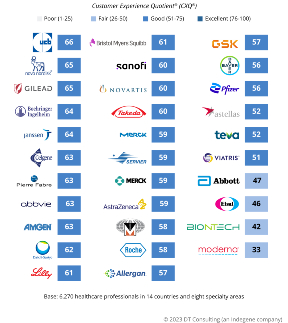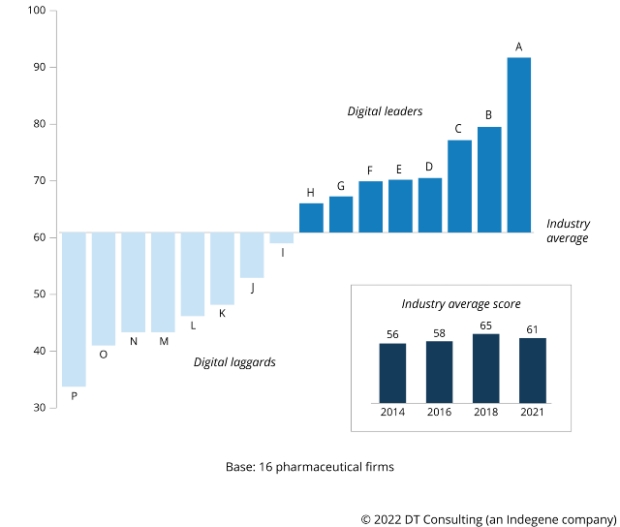Much like with ‘patient-centricity’, the overuse of ‘omnichannel’ in pharma is in danger of tarnishing the term. This would obscure the golden truth that resides at its core – that is, the way it can address pharma’s pressing need to better understand its customers’ needs and how best to meet them through a connected set of channels.
As the industry continues with the ongoing period of adjustment that characterises any omnichannel journey, one of the strongest indicators of how individual companies are performing is through the lens of the customer experience (CX) they provide. After all, if a company doesn’t shine when engaging its stakeholders, it is unlikely to find itself meeting their needs, let alone exceeding them. Currently, pharma is some way away from provide excellent customer experiences.
For its interactions with HCPs our CX research shows the industry provides what we’d consider a good, though distinctly average, level of customer experiences. Within that, digital channels as a whole lag behind their non-digital counterparts and HCPs highlight a multitude of content gaps when they talk about the information and services they want from the industry.
The picture is worse still with patients when we put them in the role of ‘customer’ to look at whether the industry meets their needs. When we last applied our Customer Experience Quotient® (CXQ®) metric to patient CX, we found pharma firms were yet to provide them with good customer experiences and consequently were failing to maximise their opportunities to improve health outcomes.
But moving beyond an omnichannel marketing approach to also incorporate a system of engagement that focuses on the customer, and not heavily on the commercials behind the brand, continues to be a major challenge for many organisations. The solution requires new behaviours, processes and ways of working – here are some of the foundational ones companies need to apply.
Smash silos to build success
Commercial teams have been prone to operating in silos for some time now, with criticism of the practice stretching back years if not a decade or more. It’s one of many ‘business as usual’ behaviours that needs to be challenged. Connecting different business units like commercial and medical teams should be a vital building block for omnichannel success, and yet too many companies are still stuck operating in isolated units, both across their organisation and even across different channels.
It’s a mould that needs to be broken so that companies can add a strong dose of customer transformation to their commercial transformation and open up such a focus away from just a CX commercial team or a digital commercial team. The problem is that, at present, most organisational structures are simply not set up to deliver on the omnichannel promise and this is why we see organisations struggling on the path to customer experience excellence.
Thoroughly understanding who and what inside the company creates customer journey success and working cross-functionally to do so are key principles of successful customer experience design and management that omnichannel needs. We often see internal hurdles like structure, culture, and established ways of working get in the way of creating a very good experience to customers.
A forward-thinking approach would be to create connective threads between commercial, clinical, and medical affairs teams. Granted, this sort of blended approach, unthinkable in the recent past, is slowly starting to emerge. But it’s a long overdue recognition that patients don’t stop being patients once they finish participating in a clinical trial, just as the industry’s key opinion leaders continue to be healthcare professionals whether they’re being engaged by medical or by commercial teams.
Develop capability maturity
Beyond the way that commercial organisations are set up and how they interact with other parts of the company, there remain some serious capability questions for pharma. Namely, are commercial organisations’ capabilities sufficiently mature to realise their omnichannel visions?
In our research into pharma’s digital maturity the biggest area of opportunity for companies was to shift their focus away from new customer-facing channels and dig in to tackle a series of complex, but highly relevant, ‘behind-the-scenes’ capabilities. Things like analytics, CX management and CRM may have less momentum behind them than more immediate, and often campaign-driven, elements like websites, events and email, but improving those ‘background’ capabilities is what pharma needs to make progress on its omnichannel journey.
Having been under-resourced in the past, many of these pharma’s behind-the-scenes capabilities have plenty more catching up to do. One area where we do see a pleasing amount of focus from the industry is from those companies looking to achieve content excellence as part of their path to omnichannel excellence. For the frontrunners this means considering the role that content hubs can play, the relationship between creative work and the production of assets, the nature of the content supply chain, and where content execution should sit, among other things.
Additionally, to assist a commercial organisation’s strategic priorities, essential characteristics such as ambition, road map, and responsibilities should be compared against its peers to reveal how efficiently transformation programmes are being run. From there, capability maturity can be further assessed by considering its adoption by customer-facing teams.
Connect data
The hope is that ‘what gets measured gets done’, as management guru Peter Drucker almost said, and there’s certainly no shortage of data in pharma, with lakes and lakes of it gathering all around companies. Huge industry investments generated lots of data, and the associated work to get it into one place is often an achievement in itself. But, just as with pharma’s major investments into technologies that allow companies to operate across channels, not all of it is connected yet.
As well as needing to act on the data that they do collect, failing to gather the data that is needed is also proving to be a key pain point for pharma companies. One reason for this is that a lot of the time progress is happening at a faster pace than individuals are able to respond to. Commercial teams are often frustrated by the disparate nature of the data they receive, some of which exists and some that doesn’t, meaning they can’t make accurate decisions about marketing plans.
Nevertheless, customer data has to be tied back to value in terms of how that data is used by commercial teams to drive insights that can make credible change to their customer programmes. That might be through a formalised CX measurement framework or an optimisation approach for channel and content investments that can help a company move from insights to action.
Develop a CX vision
All omnichannel transformations must be aligned to customer needs. The starting point for any organisation is to create a customer experience vision about what they’re trying to create or solve for their customers and how that will then create value – both for the organisation and its customers.
Proof points for such customer-centricity, and consequently support for the omnichannel strategy, can then come from measuring the resultant customer experience. Post-COVID, we see customer experience measurement growing and this helps the industry to take some big steps towards unanswered questions about customer understanding. By planning and analysing CX, commercial teams will be able to implement customer engagement improvements that will propel them further down the omnichannel path.
However, true CX thinking is still lacking in many companies and teams. Where it does happen, teams will take a strong inside-out approach characterised by a brand positioning and targeting approach. Applying CX disciplines should allow customer-facing teams to balance brand objectives with customer objectives. It’s an opportunity that starts by setting the CX vision for the organisation.
Change mindsets
As much as COVID was a ‘digital accelerant’, everything that we see from our data shows us that progress with pharma’s digital maturity is slow. When positive changes do occur in one area of an organisation’s digital readiness, they sometimes regress from one year to the next and the situation could very well continue or get worse, despite the widespread technological pivot brought by the pandemic.
So, while pharma leadership teams are now certainly convinced of the need to increase the digital investments that will contribute to omnichannel success, and the industry has got somewhat better at delivering a customer-based experience, it’s not quite there yet.
There is a point to make that pharma will never be ‘there’ with omnichannel given that it’s more a process of ongoing iterative change than a finished end state. Nonetheless, as an industry it’s clear that we could have much stronger omnichannel foundations in place if mindsets and behaviours are to be changed.
• This article first appeared in the July/August 2023 issue of PME (Pharma Market Europe)






